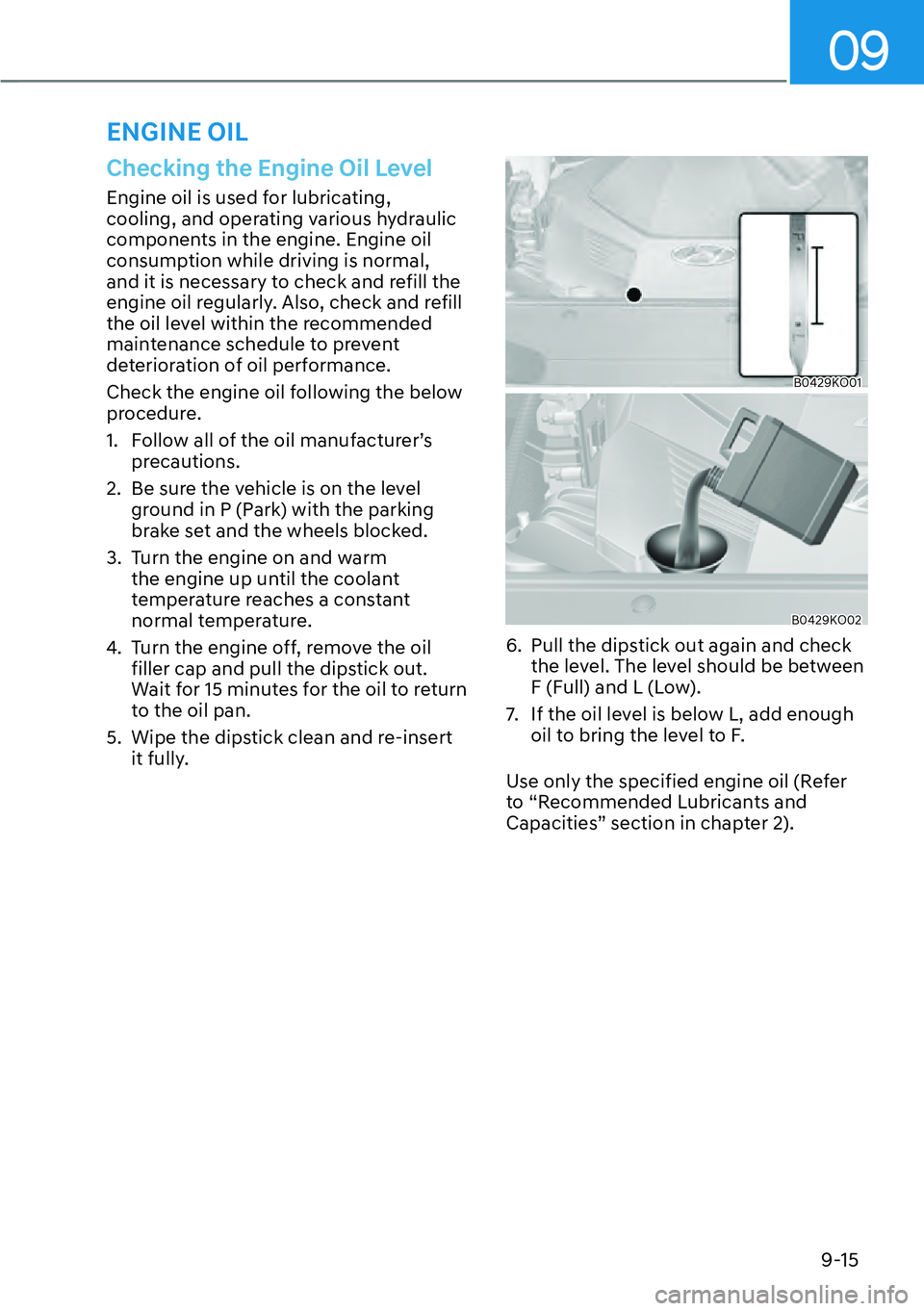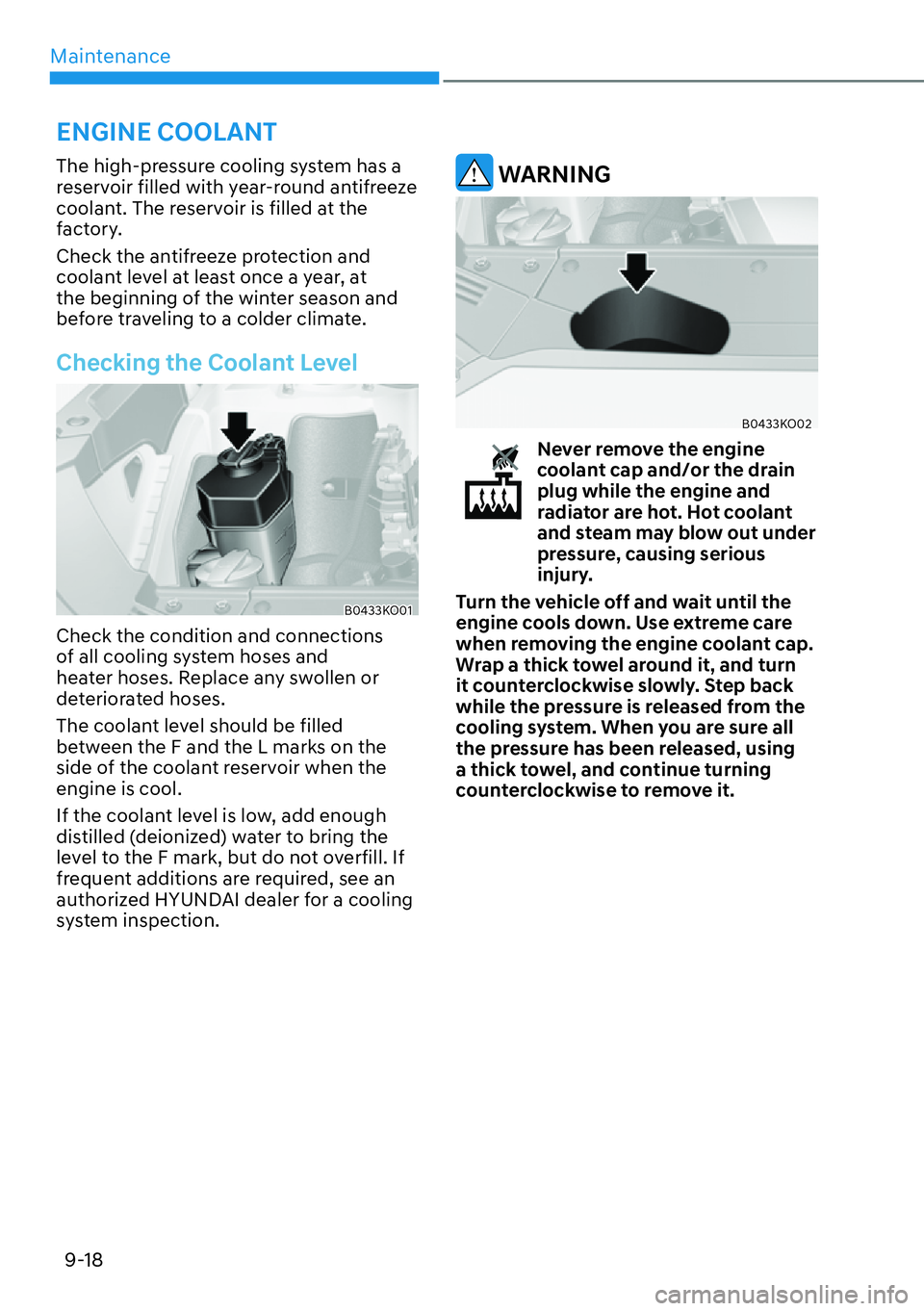Page 602 of 661

09
9-15
Checking the Engine Oil Level
Engine oil is used for lubricating,
cooling, and operating various hydraulic
components in the engine. Engine oil
consumption while driving is normal,
and it is necessary to check and refill the
engine oil regularly. Also, check and refill
the oil level within the recommended
maintenance schedule to prevent
deterioration of oil performance.
Check the engine oil following the below
procedure.
1. Follow all of the oil manufacturer’s precautions.
2. Be sure the vehicle is on the level ground in P (Park) with the parking
brake set and the wheels blocked.
3. Turn the engine on and warm the engine up until the coolant
temperature reaches a constant
normal temperature.
4. Turn the engine off, remove the oil filler cap and pull the dipstick out.
Wait for 15 minutes for the oil to return
to the oil pan.
5. Wipe the dipstick clean and re-insert it fully.
B0429KO01
B0429KO02
6. Pull the dipstick out again and check the level. The level should be between
F (Full) and L (Low).
7. If the oil level is below L, add enough oil to bring the level to F.
Use only the specified engine oil (Refer
to “Recommended Lubricants and
Capacities” section in chapter 2).
ENGINE OIL
Page 605 of 661

Maintenance9-18
ENGINE COOLANT
The high-pressure cooling system has a
reservoir filled with year-round antifreeze
coolant. The reservoir is filled at the
factory.
Check the antifreeze protection and
coolant level at least once a year, at
the beginning of the winter season and
before traveling to a colder climate.
Checking the Coolant Level
B0433KO01
Check the condition and connections
of all cooling system hoses and
heater hoses. Replace any swollen or
deteriorated hoses.
The coolant level should be filled
between the F and the L marks on the
side of the coolant reservoir when the
engine is cool.
If the coolant level is low, add enough
distilled (deionized) water to bring the
level to the F mark, but do not overfill. If
frequent additions are required, see an
authorized HYUNDAI dealer for a cooling
system inspection.
WARNING
B0433KO02
Never remove the engine
coolant cap and/or the drain
plug while the engine and
radiator are hot. Hot coolant
and steam may blow out under
pressure, causing serious
injury.
Turn the vehicle off and wait until the
engine cools down. Use extreme care
when removing the engine coolant cap.
Wrap a thick towel around it, and turn
it counterclockwise slowly. Step back
while the pressure is released from the
cooling system. When you are sure all
the pressure has been released, using
a thick towel, and continue turning
counterclockwise to remove it.
Page 606 of 661
09
9-19
Information
The coolant level is influenced by the
engine temperature. Before checking or
refilling the coolant, turn the engine off.
WARNING
The electric motor for the
cooling fan may continue to
operate or start up when the
engine is not running and can
cause serious injury. Keep
hands, clothing and tools away
from the rotating fan blades of
the cooling fan.
Always turn off the vehicle unless the
vehicle has to be inspected with the
engine on. Be cautious as the cooling
fan may operate if the negative (-)
battery terminal is not disconnected.
WARNING
Make sure the coolant cap is properly
closed after refilling coolant. Otherwise
the engine could be overheated whilst
driving.
B0433EE01
B0433EE02
1. Check if the coolant cap label is straight in front.
B0433EE03
2. Make sure that the tiny protrusions inside the coolant cap is securely
interlocked.
Page 609 of 661
Maintenance9-22
WASHER FLUID
Checking the Washer Fluid Level
B0439KO01
Check the fluid level in the washer fluid
reservoir and add fluid if necessary. Plain
water may be used if washer fluid is not
available. However, use washer solvent
with antifreeze characteristics in cold
climates to prevent freezing.
WARNING
To prevent serious injury or death, take
the following safety precautions when
using washer fluid:
�[�� Do not use engine coolant or
antifreeze in the washer fluid
reservoir. Engine coolant can
severely obscure visibility when
sprayed on the windshield and
may cause loss of vehicle control
resulting in an accident or damage to
paint and body trim.
�[�� Do not allow sparks or flame to
contact the washer fluid or the
washer fluid reservoir. Washer fluid
may contain alcohol and can be
flammable.
�[�� Do not drink washer fluid and avoid
contact with skin. Washer fluid is
harmful to humans and animals.
�[�� Keep washer fluid away from
children and animals.